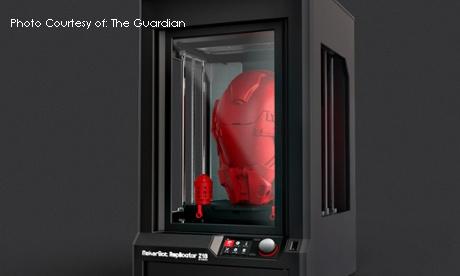
Over the past three centuries the steam engine, telegraph, and gasoline engine has propelled technology forward through a series of industrial revolutions. Recently, advances in information technology and robotics have lead to the rapid globalization and expansion of communications.
3D printing, once considered a technology of the distant future, is entering the mainstream. In fact, as each day passes, manufacturers continue to add more innovative products via the 3D printing process.
3D printing or Additive Manufacturing is the process of creating a three dimensional solid, layer by layer model. In 2012, the 3D printing industry contributed $2.2 billion to the world economy and will grow to $6.7 billion by 2017, according to the National Science Foundation.
Using the 3-D technology, BioTechnicians and medical researchers have begun to develop replaceable organs and body parts for individuals with severe injuries or unusual anatomy, according to the National Science Foundation. Once mass produced, these resources will reduce the wait for new organs and the danger of disease transmission to patients in need.
Researchers are rapidly improving the process of Bioprinting, printing tissue and organs out of organic or synthetic material. This technology has already developed prototypical skin tissue, liver, kidneys, and other vital organs.
“I see a revolution in manufacturing when it comes to the idea of 3D printing. They are exploring upon the molecular level. The aim is to have the machines print the parts and even print parts for themselves,” said Mr. Robinson, drafting and architecture teacher.
“With 3D printing technology, people will build body parts and organs right from your cells.”
The cost effectiveness of 3D technology is overwhelmingly positive for small business owners. They can easily avoid the manufacturing and even wholesaling process altogether as the 3D printer will allow all production to occur on the spot.
For entrepreneurs, 3D printing will reduce the time to design a prototype and market it to venders.
“I think entrepreneurs can use 3D printing when building their prototypes before the manufacturing process,” said Mrs. Laird, entrepreneurship and business teacher.
“People can draw the prototypes out on software where they can design it, print it, market it, then send it off to venders.”
Looking to 2014 and beyond, many schools and teachers look forward to seeing the technology in their classrooms. MakerBot Academy is leading the initiative to provide 3D printers at an affordable price.
At Leesville, the technology will likely change the way CTE [Career and technical education] and science courses operate.
“I’m trying to get it tomorrow. Mr. Kelly and I are working with things to try to build our own small 3-D printer,” said Mr. Robinson, drafting and architecture teacher.
“If I want to show my students what something looks like, then the printer will provide 3D models. Once you have the file, then you can exploit the geometry.”
With one printer running, self replication is possible. With this process, the machines can produce additional parts or even clones for all the gears and control mechanisms produced. Once completed, manufacturers and even individuals [students, teachers] can connect the parts to complete their product.
“It provides for fast prototyping. It was interesting because the 3 to 4 printers were building parts for the printer,” said Mr. Kelly, Aerospace teacher.
“Students had a demonstration [of 3D printing] at the last engineering club meeting.”
Potential Risks
With any emerging technology, threats always lurk on the horizon. While most people will take advantage of this dynamic technology, others will use it for harm against society. Currently a debate looms whether federal regulatory agencies should place restrictions on accessing the technology.
“Technology is just like anything else, some people will use it maliciously. There will always be that element but I don’t think we should heavily regulate or fear it,” said Robinson.
“The scary part is that we do not know what could come with this new technology.”
Probably the most controversial aspect of 3D printing is the creation and regulation of guns. Currently, people can 3D print guns through online open source sites with very little regulation.
Some argue that the explosive manufacturing of guns will exacerbate the crime rate, homicide rates, and mass shootings. Registering printers to regulatory agencies and mandating background checks on the materials required to manufacture the gun could solve this dilemma.
Those on the other side, especially Constitutionalists and conservatives, argue that regulation would infringe on their First Amendment (freedom of expression) and Second Amendment rights (right to bear arms.)
Another issue with 3D printing is counterfeiting and the explosion of substandard black markets. Along with printing fake currency, access to cheap materials and a printer will open access to the creation of bootlegged products. Take for example organs, tissues, and drugs– organized criminal will likely develop a complex underground economy. Since the 3D printer market is globalized, black markets could become universal.
Regardless of which side people are on, adaptive and reasonable regulation is necessary to ward off potential and unknown crisis.
Although the technology is in its beginning stages, there is uncertainty how the industry will advance the world economy; whether the industry has the potential to will temporarily stimulate or completely transform the manufacturing process.
The industry is currently opening access to needed medicine, progressing the role of the entrepreneur, exploding productivity, and adding slightly more variety in the consumer market.
Regardless of its potential impact, 3D printing is developing faster than expectations. The industry is bringing wide variety of personalization for middle class consumers and finally prices are depreciating to affordable levels.

Leave a Reply